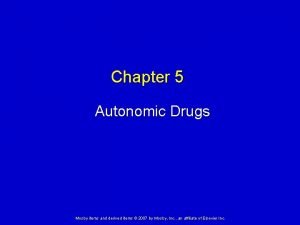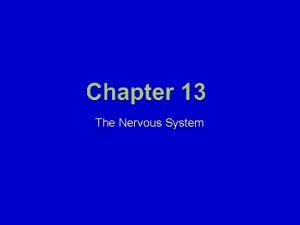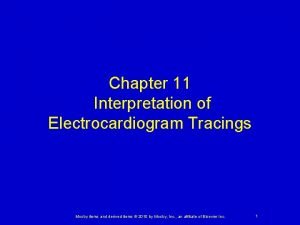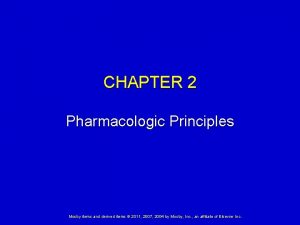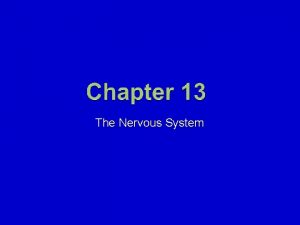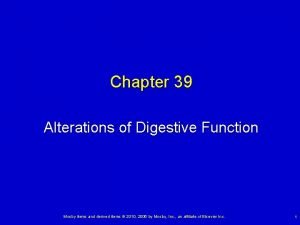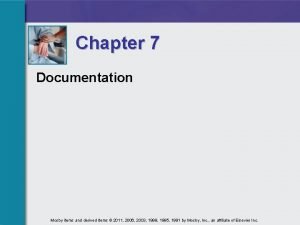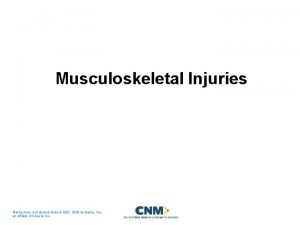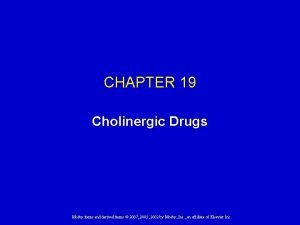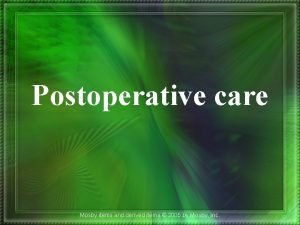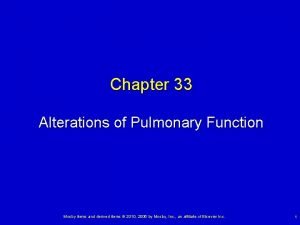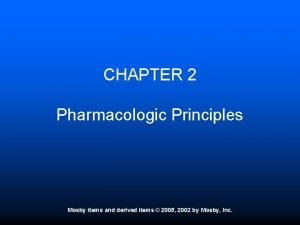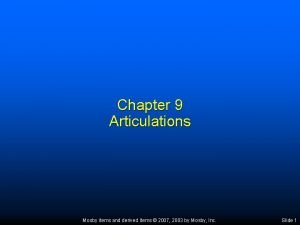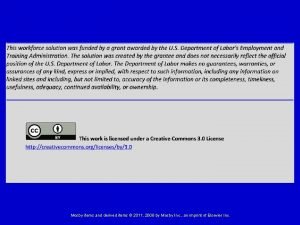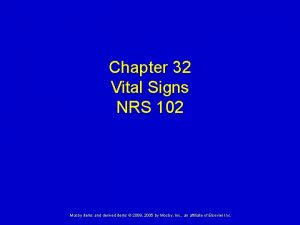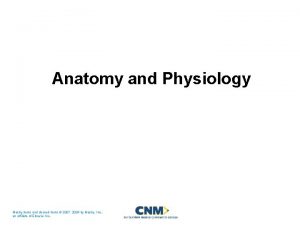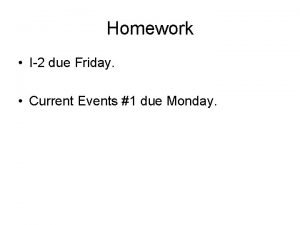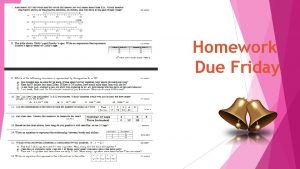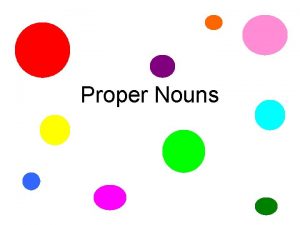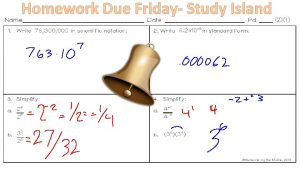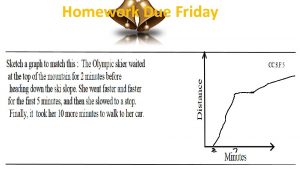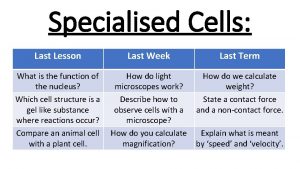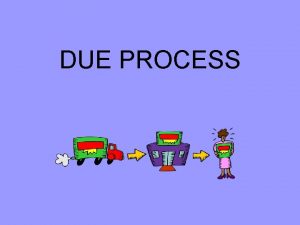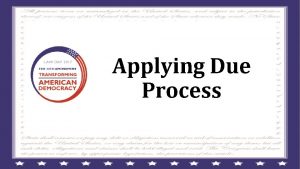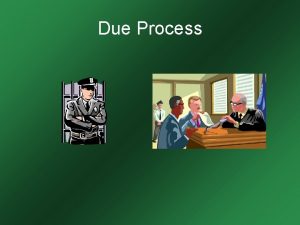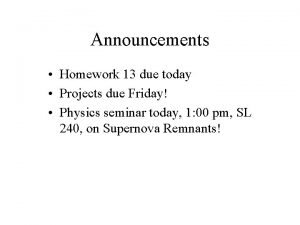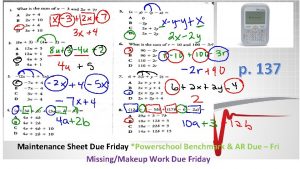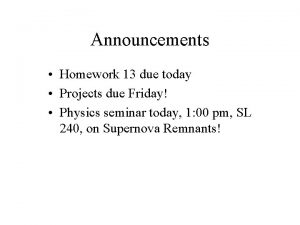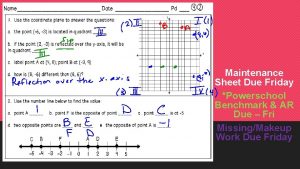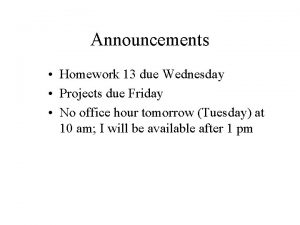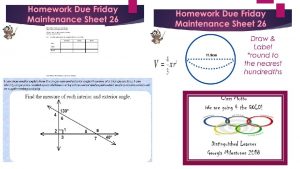Items due this week Friday of last week






























- Slides: 30

Items due this week: Friday of last week: CH 5 Questions Today: Radish seed lab Tuesday: origins of life notes (today) Wednesday: reading notes unit 2 Wednesday/Thursday: Friday: Cell Factory (CH 2, 3, 4, ) Unit 2 TEST!

Lipid Membrane, Diffusion, and Osmosis Unit 3 Flow

Reading Notes Complete reading notes for CH 6, 7, 8, 25. 1 and 25. 3 Test is scheduled for ______ Reading notes are due on that day.

Day 1 Cell Factory Assignment Complete Cell Parts handout using 3 cell ppts XC -Complete the cell factory analogy to remember the cell organelle parts.

Day 2 Origins of life and cells powerpoint Take notes! Worth points

Day 3 – Coacervates Lab – Guided Activity Read the Background information and answer the two pre-lab questions Perform the Guided Activity (page 2, front and back) Make sure you “measure” the coacervates you created. Make Start sure you note the magnification you are using the Inquiry Activity Part A What will you vary to see if coacervates still form? Base? More Acid? Surface Tension? Salt content?

Day 4 – Coacervates Lab - Inquiry Complete the “Inquiry” portion of the lab, Part B. Complete all sections of the lab. There Due will not be a formal shareout of findings Wednesday 10/7

Day 5 – Coacervates Lab - Shareout Briefly present to the class what you did for your inquiry and what results you had.

Day 6 – Notes! Take Cornell notes on the ppt: Cell Membrane and Diffusion HMWK: Read through Chapter 7 in your text book. Write a paragraph explaining how the process of diffusion works. Describe some biological processes for which diffusion is a necessary phenomenon. To which of the 4 Big Ideas (Google Search “ 4 Big Ideas AP Bio”) does the process of diffusion relate. Finally create an illustration that explains diffusion

Day 7 – Finish Notes! HMWK: Watch the Bozeman AP Biology lab video on diffusion: http: //www. bozemanscience. com/ap-bio-lab-1 - diffusion-osmosis Complete a 3 -2 -1 on the video 3 items you learned from the video 2 questions you have 1 thing that you don’t understand

Day 8 – AP Labs Diffusion and Osmosis Day A In this experiment, you will create models of living cells using dialysis tubing. Like cell membranes, dialysis tubing is made from a material that is selectively permeable to water and some solutes. You will fill your model cells with different solutions and determine where/if diffusion occurred.

Day 9 – Discussion of Day A Record your results from yesterday’s lab Answer all questions. Handout Clean due today! up: Throw Rinse away your “cells” all beakers thoroughly and set on tray to dry

Day 10 – AP Labs Diffusion and Osmosis Day B In this experiment, you will create models of living cells using dialysis tubing. Like cell membranes, dialysis tubing is made from a material that is selectively permeable to water and some solutes. You will create two cells, one filled the opposite of the other Cell #1 Inside: sugar Outside: water Cell #2 Inside: water Outside: sugar The cells will sit overnight and you will use mass to determine if OSMOSIS has occurred.

Day 11 – Discussion of Day B Record your results from yesterday’s lab Answer all questions. Handout Clean due today! up: Throw Rinse away your “cells” all beakers thoroughly and set on tray to dry

Change in Mass of Model Cells Set Up Sucrose solution in cell: Water in beaker Water in cell: Sucrose solution in beaker Group 1 Group 2 Group 3 Group 4 Group 5 Group 6 Group 7 Group 8 Class Average

Day 12 – AP Labs Diffusion and Osmosis Day C Use the computer and internet to complete Day C. Links are on my website Review of terms: http: //www. youtube. com/watch? v=s 3 t. Eg. NPox 3 g Plasmolysis in red onion cell-with explanation http: //www. youtube. com/watch? v=Sw 87 Q 53 NZLI Plasmolysis in elodea cell-no explanation http: //www. youtube. com/watch? v=Soo. Ss. Kk. Jo 1 o

Day 13 Water Potential – aka “Osmotic Pressure” The tendency of water to leave one place in favor of another place. Water ALWAYS moves from an area of higher water potential to an area of lower water potential. In animals…. water moves into or out of a cell depends on solute concentration on either side of the cell membrane ( cells lyse or shrink) In plants…. . Affected by two factors because of cell wall: Pressure exerted by cell wall on cell membrane (think balloon trapped in a box) Amount of solute (ions) Formula for water potential is:

In plants, pressure exerted by the rigid cell wall that limits further water uptake (also known as TURGOR PRESSURE) Pure water has solute potential of ZERO. As solute is added, the value for solute potential becomes more negative. This causes the water potential to decrease also. As solute is added, the water potential of a solution drops, and water will tend to move into the solution. In the laboratory, we use “bars” as the unit of measure for water potential. 1 bar = approximately 1 atm

Examples: Cell in distilled water. Water potential outside = 0 Water potential inside = (-) since cells contain solutes which have a negative solute potential Water will move into the cell since inside cell is more negative Over time, the inflow of water into the cell causes pressure to build (positive turgor or pressure) which will eventually override the negative from the solute potential. Eventually the water potential inside and outside the cell will equal each other and net water movement ceases Note, I said “net” water movement. Equilibrium still means movement is occurring. It just means the water going in equals the water moving out of the cell

Day 13 (cont’d) – AP Lab Diffusion and Osmosis Day D Design an experiment to identify the Molar (M) concentrations of the sucrose solutions and use the solutions to determine the water potential of the plant tissue.

Day 13 (cont’d) – AP Lab Diffusion and Osmosis Day D Procedures: 1. Cut four (4) potato cubes (DO NOT include skin). 2. Mass your four cubes (1 set) for Initial weight. 3. Place cubes in cups with sucrose solution molarity. Label cups 4. Make observations and place cups in order of Molarity. 5. Let it stand overnight (24 hrs) 6. Mass your four cubes for Final weight. Calculate % change in mass. 7. Construct a Graph with class data

Day 14 – AP Labs Diffusion and Osmosis Day D Perform your lab Answer all questions Due 10/21

Day 15 – AP Lab Diffusion and Osmosis Day D…results Record your lab results Answer all parts of the lab Due 10/21 Clean up: Throw Rinse Change in mass = final mass – initial mass % change = change in mass initial mass away potato pieces (not in sink!!!!) all beakers thoroughly and set to dry on tray x 100

Day 16 – Enzyme notes CH 8 – Enzymes Take notes on the powerpoint. Will be worth points

Day 16 Hmwk: Write a paragraph to answer the following: Why are cells so small? And why do they have cell membranes with so many convolutions? Use words like: diffusion, volume, surface area, etc…

Day 17 – Enzyme notes (cont’d) Notes Summary Questions…. . 1. Illustrate and label a generic enzyme and substrate. Explain the relationship among the different parts. 2. What are the first two laws of thermodynamics and how do they relate to enzymes? 3. What is meant by spontaneous reaction and activation energy? How do enzymes affect this? 4. What is meant by exergonic reactions and endergonic reactions? 5. Enzymes can be activated or inhibited. Explain the different ways in which this happens. 6. How do p. H and temperature affect reaction rates?

Day 18 – Enzyme lab(s) Catalase Complete your parts of the lab Write up due _____

The END!

Day 5 – Internet Search Research information about cell membranes (aka the lipid bilayer). This is a “fact-finding mission”. Your quest is to discover and document information (research, structure, function, et…anything related to the cell membrane) about the cell membrane. You will compile your findings (from today’s research) along with important websites – on a piece of binder paper (with a title). HMWK: make a summary of your findings (from today’s research) that you will turn in 10/7/14.

Day 4 – cell membrane research shareout After each person shares what they learned about the cell membrane, fill in the following chart: Presenter I learned: I am unclear on:
 Mosby items and derived items
Mosby items and derived items Mosby items and derived items
Mosby items and derived items Mosby
Mosby Mosby items and derived items
Mosby items and derived items Mosby items and derived items
Mosby items and derived items Mosby items and derived items
Mosby items and derived items Mosby items and derived items
Mosby items and derived items Mosby items and derived items
Mosby items and derived items Acuity charting forms
Acuity charting forms Mosby items and derived items
Mosby items and derived items Mosby items and derived items
Mosby items and derived items Mosby items and derived items
Mosby items and derived items Mosby items and derived items
Mosby items and derived items Mosby items and derived items
Mosby items and derived items Mosby items and derived items
Mosby items and derived items Mosby items and derived items
Mosby items and derived items Mosby items and derived items
Mosby items and derived items Mosby items and derived items
Mosby items and derived items Mosby items and derived items
Mosby items and derived items Mosby items and derived items
Mosby items and derived items Mosby items and derived items
Mosby items and derived items Mosby items and derived items
Mosby items and derived items Mosby items and derived items
Mosby items and derived items Mosby items and derived items
Mosby items and derived items Mosby items and derived items
Mosby items and derived items Mosby items and derived items
Mosby items and derived items Mosby items and derived items
Mosby items and derived items Is due on friday
Is due on friday Homework is due on friday
Homework is due on friday Homework is due on friday
Homework is due on friday Saturday proper noun
Saturday proper noun
